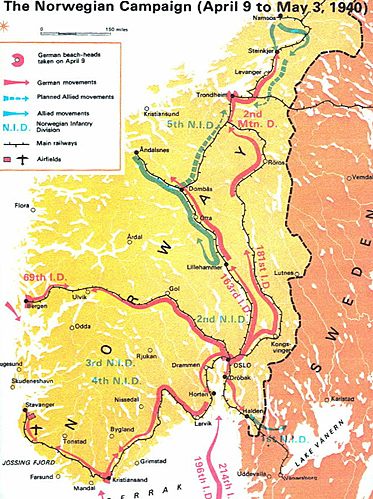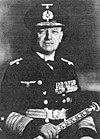
During the Second World War, to protect her northern sea flank, the German Navy launched one of the most daring attacks ever undertaken by a very numerically small Navy. The strategic importance of Norway was enormous for Germany. Much of the iron ore shipments came from Sweden and Norway, through Norwegian waters to Germany. The British were likely to lay mines across the North Sea and Norwegian neutral waters, just as they had done in World War I.
Map from: Illustrated World War II Encyclopedia.
This would endanger German submarine and surface-warship movements across that route, and more importantly would seriously disrupt the iron ore shipments coming to Germany. If the British and her Allies moved into Northern Norway and Sweden, then Germany's iron ore supplies would be totally cut. And an Allied move into southern Germany would threaten northern Germany and the Baltic Sea, endangering German shipping and submarine fleet training. Also, by acquiring air bases in southern Norway, the Allied Air Forces could launch air attacks on northern Germany specially targeting German Naval fleet bases.
If the Germans captured Norway then not only would Germany's iron ore supplies be ensured without interruption, but would also provide her Air Forces and Naval Forces with bases, from where they could menace Britian's lines of communications-and Great Britain herself.
Then the Russians attacked Finland on November 30, 1939, and the situation changed dramatically. Because the Russians and Germans had sealed off southern portion of Finland, the Allies, had no alternative, but to supply the hard pressed Finns through northern Norway and Sweden. Germany feared that the Allies might take advantage of the situation and move into Norway and Sweden, thus seizing Germany's precious sources of iron ore. The chartering to England of 90 percent of the Norwegian tankers was very carefully noted and studied. The German Naval Operations Staff, however, felt that the British and her Allies would not attack Norway because, if they did, the Germans would counter it by moving into Sweden, Denmark and southern Norway. Also if the British and her Allies captured Norway, they would be risking war with Russia and the German Naval Staff, accurately predicted, that the British would not move into Norway at this point in time.
 On February 23rd, Grand Admiral Erich Raeder (at right: from The German Navy in World War 2), the Commander-in-Chief of the German Navy, pointed out to Hitler that although Norway's neutrality was still the most desirable course, but under no circumstances should Norway be
allowed to fall into British hands. Agreeing with Navy's reasoning that
British and her Allies might attack Norway, Hitler issued his Norway
Directive on March 1, 1940. The whole operation was planned as a surprise
move of small groups of forces, transported by sea and air and protected by
Naval and Air Forces. Army General Nikolaus von Falkenhorst was put in
command of this operation. Colonel General Alfred Jodl's Operations Staff
at O.K.W had general control of the Norway operation. Naval Groups West and
East had control of the warships and had authority over naval operations.
German Naval Operations Staff, under Raeder, was concerned with strategic
and operational planning, and had direct control of all raiders and their
supply and intelligence systems. Air Force Headquarters, based in Berlin,
had control of fighters, bombers, and transport aircrafts. General
Falkenhorst, who had a special three-service staff working with him,
controlled the land forces and also had tactical and operational control of
aircraft in the combat zone.
On February 23rd, Grand Admiral Erich Raeder (at right: from The German Navy in World War 2), the Commander-in-Chief of the German Navy, pointed out to Hitler that although Norway's neutrality was still the most desirable course, but under no circumstances should Norway be
allowed to fall into British hands. Agreeing with Navy's reasoning that
British and her Allies might attack Norway, Hitler issued his Norway
Directive on March 1, 1940. The whole operation was planned as a surprise
move of small groups of forces, transported by sea and air and protected by
Naval and Air Forces. Army General Nikolaus von Falkenhorst was put in
command of this operation. Colonel General Alfred Jodl's Operations Staff
at O.K.W had general control of the Norway operation. Naval Groups West and
East had control of the warships and had authority over naval operations.
German Naval Operations Staff, under Raeder, was concerned with strategic
and operational planning, and had direct control of all raiders and their
supply and intelligence systems. Air Force Headquarters, based in Berlin,
had control of fighters, bombers, and transport aircrafts. General
Falkenhorst, who had a special three-service staff working with him,
controlled the land forces and also had tactical and operational control of
aircraft in the combat zone.
The Strategic and tactical plans for this operation were both bold and daring. The German Air Force would send paratroops to southern Norway to capture the airfields at Oslo and Stavanger. Once these were captured, additional troops would be brought in by air transport. Fighters would gain air supremacy by knocking out the small Norwegian Air Force, and would at the same time attack the British, and provide air escort for German Bombers.
The bombers would make concentrated heavy attacks on Norwegian strong holds and its lines of communications. Cruisers and many smaller ships of the German Navy would land troops at four different locations in southern Norway. They would attack area from Oslo to Bergen and capture its harbors.
In northern Norway, attacks were planned on Narvik, and Trondheim. Troops would be landed from a cruiser and fourteen destroyers, shielded and supported by two small battleships. To distract the British Fleet, the pocket battleship Lutzow (formerly Deutschland), would break into the Atlantic ocean and attack commerce. Submarines would search and destroy any British counter moves and also protect the German troopships once they enter the Fjords. Reinforcements would arrive once the initial objectives were captured.
More Naval Battle of Norway
Back to Table of Contents -- World War Two Newsletter April 2002
Back to World War Two Newsletter List of Issues
Back to MagWeb Magazine List
© Copyright 2002 by Shahram Khan.
This article appears in MagWeb (Magazine Web) on the Internet World Wide Web.
Other military history articles and gaming articles are available at http://www.magweb.com